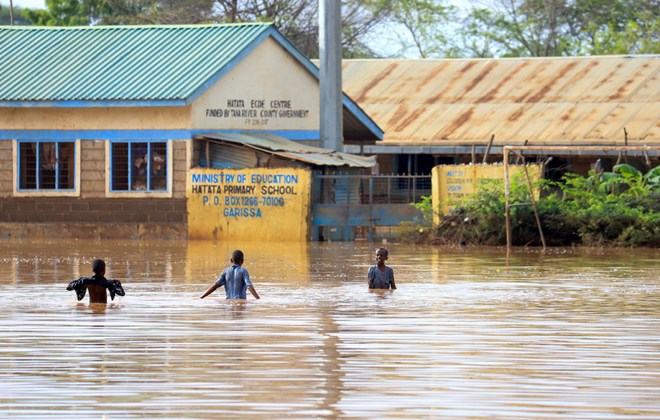Kenya is grappling with the aftermath of floods caused by ongoing El Nino rains that have killed at least 38 people and displaced about 30,000 across the east African country in the last two weeks, according to the Kenya Red Cross (KRC).
The most affected are residents in arid and semi-arid areas like Tana River, Makueni, Wajir, Isiolo, Marsabit and Mandera counties, who were still recovering from the effects of the worst drought in 40 years.
In Tana River County, River Tana broke its banks and flooded homes, farms, schools and places of worship, displacing hundreds of residents, who have sought refuge along the roadside waiting for the water levels to subside. A similar situation has engulfed Garissa County, where businesses, farms and homes are submerged, disrupting lives.
“Our business premises have been flooded for the last three days after heavy rains. We are stranded and sources of livelihoods have been cut off,” Jacob Otieno, a mechanic, told a local television station.
The KRC put the number of those displaced by floods in the main town at 2,000, and across Garissa County at 20,000, a majority of the people currently living in camps.
Mohammed Abdikadir, KRC regional manager, said the number of those affected is growing faster. “We are facing a humanitarian crisis as thousands in northern Kenya are in need of assistance. The number is growing faster as rains continue,” Abdikadir told the local television station, adding that in some areas, road access has been completely cut off by floods, marooning entire communities.
The KRC noted that 18 counties out of the 47 in Kenya have been affected by the floods.
In Isiolo County, hundreds of residents have lost their livestock that include goats and sheep, to raging floods, which also rendered them homeless.
It is a double tragedy for the residents in the county and others like Makueni in eastern Kenya, who were rebuilding their lives after a prolonged drought that ended in April. Some 2 million animals, including goats, sheep, cows and camels, died during the drought, according to the National Drought Management Authority (NDMA).
In its October report, the NDMA said at least 2.8 million people in 23 regions that were severely hit by drought were still in need of food assistance. The number had declined from the initial 4.4 million due to heavy rainfall recorded during the March-May season, which boosted food production.
The NDMA had expected conditions in the arid areas to improve with the onset of the October-to-December rainy season. However, with the ongoing heavy rains, the situation is likely to worsen as the crisis transitions from drought to floods.
As the rains grow in intensity, more areas are expected to be affected, leading to more deaths, destruction and displacements.
“Heavy rainfall from #ElNino is causing widespread flooding in Kenya, disrupting essential services & endangering lives. @KenyaRedCross is providing relief, but urgent humanitarian assistance is needed due to the threat of further flooding,” the International Federation of Red Cross Africa said in a post on social media platform X, formerly known as Twitter.
Kilifi County at the coast and Budalangi, in Busia, western Kenya, are among areas that are on high alert due to possible flooding.
Kenya has formed a National Emergency Response Committee to attend to the flood crisis. “Working with our development partners, counties, and other key agencies, we are distributing food and non-food items to tens of families affected to reduce their suffering,” Deputy President Rigathi Gachagua said on Friday.
Kenya and neighboring Ethiopia and Somalia are among the countries in the Horn of Africa predicted to experience heavy rains and flooding between October and December, affecting millions of people.
The IFRC noted that with 146 million people across 23 African countries already facing prolonged hunger, the heavy rains from El Nino intensify the threat.
Source: Xinhua
